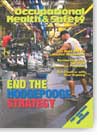
January 2006
- End the Hodgepodge Strategy
- The Right PPE for Disaster Responders
- Restaurant Cards Spice Up Incentive Programs
- Get Creative with Your Training
Click here to subscribe.
Cover Story
By Jerry Laws
Editor's note: Anti-fatigue matting is hot right now--and it's not just for human workers, says Greg Clouse, the industrial and agricultural matting sales manager for Koneta Inc. (www.konetainc.com) of Wapakoneta, Ohio. Koneta, which makes mats, trucks' splash guards, and other products, has been certified to QS-9000/ISO-9002 Quality System requirements and ISO 14001 Environmental Management System requirements.
Features
By Casey Hayes
When one begins to reflect the impact of possible multiple concurrent injuries from a single major event, the demands of a plant-wide design can be extremely complex.
By Larry Johnson
IN recent years, we Americans have experienced more than our share of natural and man-made disasters. From the six major hurricanes that struck Florida during the past two years to oil spills, tornadoes, and the devastating acts of terrorism on Sept. 11, 2001, and the Oklahoma City bombing, first responders and cleanup personnel have been required to work with a variety of catastrophic situations and related hazards.
By Don Groover, CIH, CSP
PROVIDING individual-specific feedback is one of the most inexpensive and powerful tools in the arsenal of a leader. And of all leadership practices, few so perfectly balance a leader's dual tasks of establishing performance expectations and creating the conditions conducive to meeting those expectations.
By Larry L. Janssen, CIH, Bob Weber, CIH
MANY respirator program managers have been taught that respirator faceseal leakage increases directly with increased breathing resistance. If this were true, an increase in breathing resistance (pressure drop) because a particle filter has become loaded with a solid aerosol (clogging) would be expected to increase the wearer's contaminant exposure via increased faceseal leakage.
By Shelli Cosmides
THE operating philosophy and the challenge facing the emergency services component of a major U.S. city is to be prepared for anything and to protect the area's 2 million residents. The city's Bureau of Operations includes the fire department, emergency medical technicians, paramedics, four heavy rescue units, and a special hazardous materials team.
By Sanford Woo, CSP, CHMM
By D. Jeff Burton, PE, CIH
WHAT are portable air cleaners (PACs) and how are they used? Portable air cleaners (PACs) are small hand transportable air cleaning units used in occupied spaces (classrooms, offices) to reduce the concentration of airborne particles and sometimes vapors and gases. They typically weigh 10-20 lbs, are freestanding, use local electrical current, and can be placed anywhere in a room.
By Joe Ziemba
WHEN a fire breaks out, the immediate need to evacuate, contain, and suppress overshadows any thought about future contingency planning. The goal is to get out alive and put the fire out. Tomorrow will bring its own set of problems, or so the thinking goes.
By Andrew Balaschak
ON January 6, 2005, a 42-car train traveling at approximately 40 mph through Graniteville, S.C., crashed into a parked locomotive. A number of the cars contained hazardous chemicals: resins, kaolin, and sodium hydroxide. Three cars were 90-ton tankers, each carrying full loads of chlorine.
By Deborah R. Roy, MPH, RN, COHN-S, CET, CSP
IN order to succeed in today's competitive world, health and safety professionals may find the need to expand their skill sets and credentials. Companies are often seeking a generalist who can address a variety of health, safety, and environmental issues instead of hiring several different specialists. As licensed professionals, occupational health nurses are uniquely positioned to expand their practice into the safety and environmental disciplines.
By Jeffrey Duffy, Ph.D., DABT, CIH
HEXAVALENT chromium (CrVI) compounds are used in a variety of industries where potential exposures may occur. Metal plating, the use of pigments containing CrVI, and chemical synthesis where CrVI is used as a catalyst or as an ingredients can result in worker exposure. Welding on CrVI-painted surfaces can also result in the generation of CrVI.
Departments
By Jerry Laws
Editor's note: The wide variety of today's safety incentives continues to amaze. Their growing popularity is less surprising. Recipients certainly appreciate restaurant gift cards when they are used as an incentive, says Cary Kuykendall, manager of gift card sales for O'Charley's (www.ocharleys.com) of Nashville, Tenn. The NASDAQ-traded company operates O'Charley's restaurants mainly in the Southeast and Midwest; a chain of Ninety Nine Restaurant & Pub locations in the Northeast; and also Stoney River Legendary Steaks restaurants in Georgia, Illinois, Kentucky, and Tennessee.
By Jack Philley, CSP
SMALL changes in investigation technique can sometimes produce large improvements in incident investigation results. This article discusses several common weaknesses found in investigation management systems.
By Marc Barrera
IT'S a hot, blistering day on the construction site. A worker stops to notice an attractive lady walking by confidently. She's secretly ready to barrage him with a stream of obscenities at the first sound of a whistle and sure enough, one rings clearly above the construction din.
By Jerry Laws
THIS magazine and I are hitting milestone birthdays. Mine, turning 50, happened in 2004. But I'm a generation younger than Occupational Health & Safety, which will see its 75th birthday this year.